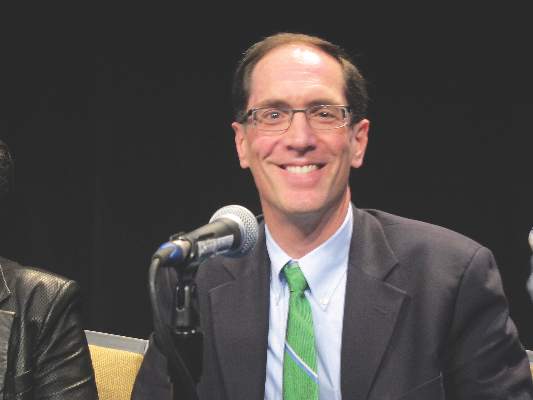EXPERT ANALYSIS FROM 2015 ADVANCES IN IBD
ORLANDO (FRONTLINE MEDICAL NEWS) – To delay or prevent recurrence of Crohn’s disease in patients after they’ve undergone ileocolonic resectioning, the ultimate question is where the “sweet spot” is for timing biologic therapy.
“In 2016, symptoms will still guide treatment,” said Dr. Miguel D. Regueiro , professor of medicine at the University of Pittsburgh and clinical medical director of the University’s IBD Center, during the clinical track of this year’s annual Advances in Inflammatory Bowel Diseases meeting, sponsored by the Crohn’s and Colitis Foundation of America. But when it comes to the exact timing of administering anti–tumor necrosis factor (TNF) agents, clinicians should look to risk factors for recurrence.
The notion that immediate treatment with a biologic after surgical resectioning is best is supported by phase III data from the international, multicenter PREVENT trial , for which Dr. Regueiro was principal investigator. It demonstrated that at week 79 and week 104, immediate treatment with the biologic infliximab 5 mg/kg every 8 weeks postsurgery in patients with high risk for recurrence (smokers, those with penetrating or fistulizing disease, or a history of resectioning) resulted in lower but not statistically significant rates of the composite endpoint of clinical recurrence and endoscopic scores greater than 2, when compared with placebo (P = .097 at 76 weeks and P = .098 at 104 weeks).
Dr. Regueiro noted in an interview that often, even though endoscopic recurrence scores might be high, following surgery, patients are in clinical remission and so do not report any symptoms. He noted that when only endoscopic outcomes prior to or at week 76 in the PREVENT trial were analyzed as the secondary endpoint, there was a statistically significant difference when compared with placebo: The 147 randomly assigned study arm participants had a recurrence rate of 22.4% vs. 51.3% in 150 controls (P less than .001). Further, Rutgeerts scores equal or greater than i-3 occurred in 83.1% of participants in the placebo group, compared with 28.4% in the infliximab group at week 76.
“The take-home message is that surgery induces a deep remission where patient’s ‘feel well’ and by using a clinical symptom score we do not detect recurrence, probably for years,” Dr. Regueiro said in the interview.
What about waiting to offer treatment?
Results from the POCER trial , also conducted internationally at a number of centers, support this approach.
In the trial, 174 postoperative patients at high risk for recurrence were randomly assigned in a 2:1 ratio to either standard care – colonoscopy at 18 months – or to receive a colonoscopy at 6 months, followed by medication if there was an endoscopic recurrence of i-2 or greater.
Both study arms were given metronidazole 400 mg twice a day for 3 months. If patients were intolerant, the dose was reduced to 200 mg twice daily or was stopped altogether. If they were high risk but medication naive, patients were given azathioprine 2 mg/kg or 6-mercaptopurine 1.5 mg/kg once daily, beginning within 1 month after surgery. Patients intolerant to this regime were administered adalimumab 160/80/40 mg accordingly, every other week.
At 18 months, those patients who’d been observed endoscopically at 6 months and given medication if necessary had a 49% rate of recurrence compared with 67% in the group given standard care, a statistically significant difference.
However, when Dr. Regueiro, who was not directly involved with the POCER trial, conducted an informal review of the data, he found that patients who’d been on thiopurines had an endoscopic recurrence rate at 6 months of 45% vs. the 21% rate in the adalimumab patients. “This means that waiting on anti-TNF and giving thiopurine meant nearly half the patients had recurrence in 6 months, compared with anti-TNF treated patients.”
So then, when should biologics enter the treatment picture?
Again, look to the risk profile, said Dr. Regueiro. Patients who are 30 years of age or younger, have ileocolonic disease, smoke, have penetrating disease, or have already had two or more surgeries or had a short duration between time of diagnosis and surgery are considered at high risk for return of the disease.
In his own practice, Dr. Regueiro said he puts all but the low-risk patients on some form of immediate postoperative medication. Patients at moderate risk, such as those who have had a resection within 10 years of diagnosis, receive 6-mercaptopurine or azathioprine plus metronidazole (if tolerated) and are given colonoscopy at 6-12 months postoperatively. If there is a recurrence at that point, then he will start the patient on an anti-TNF. If not, then he sees them again in 1-3 years for a colonoscopy. Dr. Regueiro treats patients at high risk for recurrence more frequently with combination therapies, immediately setting them on a regimen of anti-TNF plus immunosuppressive therapy followed by a 6-12 month postoperative colonoscopy after which he adjusts treatment if there is active disease, including increasing the dose of the biologic or switching to another one.
But just what length of time actually constitutes “immediately after surgery?” In the PREVENT trial, clinicians had up to 45 days to begin therapy, although Dr. Regueiro said he prefers to start between 2 and 4 weeks postsurgery, a number with which panel moderator Dr. David T. Rubin , codirector of the University of Chicago Digestive Diseases Center, agreed.
While these study results help pinpoint the range for when to use biologics, Dr. Regueiro said in the interview, “Future study is need to determine the ‘tipping point’ where postoperative Crohn’s disease recurrence results in significant bowel damage and renders medications ineffective. Finding the ‘biologic sweet spot’ of when to start aggressive therapy versus a ‘wait and watch’ approach remains the question.”
Dr. Regueiro disclosed he is a consultant for AbbVie, Janssen, UCB, Pfizer, and Takeda.
On Twitter @whitneymcknight






